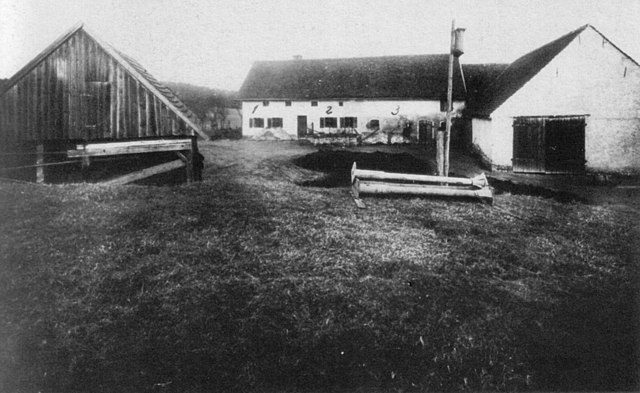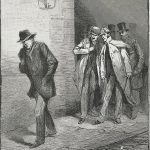
The Hinterkaifeck murders stand as one of the most chilling and perplexing cases in German history. Nearly a century later, the crime remains unsolved, baffling investigators, historians, and crime enthusiasts alike. The gruesome nature of the murders, combined with the eerie circumstances surrounding them, has ensured that the Hinterkaifeck case continues to haunt the imagination of many. This unsolved mystery has not only left a lasting impact on true crime narratives but has also deeply influenced art and literature. As we delve into this sinister story, we uncover the horrifying details of the murders and explore their significant influence on the creative world using their craft to find answers and lessen the darkness.
The Mysterious Setting of Hinterkaifeck
Hinterkaifeck was a small, isolated farmstead located about 70 kilometers north of Munich, in the German state of Bavaria. The farm was home to the Gruber family, consisting of Andreas Gruber, his wife Cäzilia, their daughter Viktoria, and her two children, Cäzilia and Josef. Additionally, the family had recently hired a new maid, Maria Baumgartner, who had only started working on the farm the day before the tragedy.
The farmstead’s isolation played a critical role in the events that would unfold. The farm was situated far from its neighbors, making it a perfect setting for a crime shrouded in mystery. According to local lore, the farm had always carried an air of strangeness. Andreas Gruber was known to be a strict and somewhat reclusive man, and the family was not particularly well-liked by the community. However, no one could have anticipated the horrors that were about to occur.
The Eerie Prelude to the Crime
In the weeks leading up to the murders, a series of strange occurrences began to unsettle the Gruber family. It all started with unexplained footsteps in the snow leading from the woods to the farm but not away from it. The family also heard strange noises coming from the attic, but upon investigation, they found nothing. Andreas Gruber reported these incidents to his neighbors, but no one took them seriously.
Moreover, Viktoria mentioned to her friends that she had found a newspaper on the farm that no one in the family had purchased. It seemed as though someone was watching the family, lurking in the shadows. Despite the unnerving events, life on the farm continued as usual until the fateful night of March 31, 1922.
The Horrific Discovery
On April 4, 1922, concerned neighbors went to check on the Gruber family after noticing their prolonged absence. What they found was beyond comprehension. The entire family, along with the new maid, had been brutally murdered. Their bodies were discovered in the barn and the house. The manner in which the bodies were found suggested that the victims had been lured one by one to the barn, where they were killed with a mattock, a type of large pickaxe. The two-year-old Josef and the maid, however, were killed inside the house.
The brutality of the murders shocked the entire community. The killer or killers had covered the bodies with hay and bedding, and bizarrely, they seemed to have stayed in the house for several days afterward. Food had been eaten, the cows had been milked, and someone had even fed the family’s dog. Yet, despite this macabre occupation of the farm, the perpetrator(s) left no trace behind.
The Baffling Investigation
The police investigation into the Hinterkaifeck murders was as baffling as the crime itself. Despite extensive efforts, no definitive suspects were ever identified. The police questioned numerous individuals, including disgruntled former workers, local villagers, and even Viktoria’s rumored lovers. However, none of these leads led to any arrests.
One of the most perplexing aspects of the case was the lack of clear motive. Although the crime scene had been thoroughly searched, no significant amount of money or valuables appeared to be missing. This suggested that robbery was not the motive. Some speculated that the murders were driven by personal vendettas or deep-seated family disputes, but no concrete evidence was ever found to support these theories.
As time went on, the case grew colder. The police eventually turned to clairvoyants and psychics in a desperate attempt to solve the mystery, but even their insights proved fruitless. The Hinterkaifeck murders became one of Germany’s most notorious unsolved crimes, leaving behind more questions than answers.
The Chilling Influence on Art
The Hinterkaifeck murders have cast a long shadow over the art world, particularly in Germany. Artists and writers have been drawn to the case, exploring its dark themes and eerie atmosphere through various creative mediums. The unsolved nature of the crime, coupled with the brutality involved, has provided fertile ground for artistic interpretation and expression.
One notable artist who drew inspiration from the Hinterkaifeck murders is Gerhard Richter, a German painter known for his haunting and blurred photo-paintings. Although Richter’s works do not explicitly depict the crime, they evoke a sense of unease and mystery that resonates with the chilling atmosphere of Hinterkaifeck. His art captures the uncertainty and fear that surrounds the unsolved case, leaving viewers with a lingering sense of dread.
In addition to visual art, the case has also inspired numerous works of literature. Crime writers, in particular, have found the Hinterkaifeck murders to be a compelling subject. The lack of resolution and the bizarre details of the crime have allowed authors to explore themes of paranoia, fear, and the unknown. For instance, the case is referenced in several crime novels, where the chilling details are woven into fictional narratives that explore the darker side of human nature.
Moreover, the Hinterkaifeck murders have also influenced contemporary art installations and performances. Artists have used the story to comment on the nature of violence, the fragility of human life, and the elusive search for truth. These works often play with the viewer’s perception, much like the case itself, leaving them to question what is real and what is imagined.
Literature’s Dark Fascination
The Hinterkaifeck murders have left a significant mark on literature, particularly in the crime and horror genres. The unsolved nature of the case, combined with the gruesome details, has made it a compelling subject for writers seeking to explore the darker aspects of human nature and the mysteries of the human psyche.
One of the most prominent examples of the case’s influence on literature is found in the works of German crime fiction. Authors have drawn from the case to create stories that delve into themes of isolation, madness, and the unknown. The Hinterkaifeck murders serve as a backdrop for exploring the human capacity for violence and the ways in which fear and suspicion can tear communities apart.
In addition to crime fiction, the case has also influenced horror literature. The eerie setting of the isolated farm, combined with the unexplained events leading up to the murders, provides a perfect template for horror stories. Writers have used the Hinterkaifeck murders as inspiration for tales that blur the lines between reality and the supernatural, creating narratives that leave readers with a lingering sense of unease.
Furthermore, the Hinterkaifeck case has inspired non-fiction works that seek to uncover the truth behind the murders. These books often take a historical approach, examining the case in the context of early 20th-century Germany and exploring the social and psychological factors that may have contributed to the crime. While these works aim to shed light on the case, they also acknowledge the mystery that continues to surround it, leaving readers to ponder the unanswered questions.
The Case in Film and Media
The influence of the Hinterkaifeck murders extends beyond visual art and literature into the world of film and media. The case has been the subject of several documentaries, feature films, and television shows, each offering its own interpretation of the events. These adaptations have helped to keep the story of Hinterkaifeck alive in the public consciousness, ensuring that the mystery continues to captivate new generations.
One of the most notable film adaptations is the 2009 German film “Hinter Kaifeck,” directed by Esther Gronenborn. The film takes a fictionalized approach to the story, blending elements of horror and psychological thriller to create a tense and atmospheric narrative. The film’s depiction of the isolated farm and the eerie events leading up to the murders captures the unsettling atmosphere that has made the case so enduring.
In addition to feature films, the Hinterkaifeck murders have also been the subject of several television documentaries. These documentaries often take a more factual approach, examining the details of the case and exploring the various theories that have emerged over the years. However, even in these more straightforward retellings, the mystery and horror of the crime are palpable, reminding viewers of the darkness that still shrouds the case.
Furthermore, the case has been referenced in popular crime shows and podcasts, where the Hinterkaifeck murders are often cited as one of the most chilling unsolved crimes in history. These references help to keep the story alive, ensuring that the Hinterkaifeck murders remain a topic of discussion and speculation in the media.
Artistic Interpretations of the Unsolved Crime
Artists have long been fascinated by unsolved crimes, and the Hinterkaifeck murders are no exception. The lack of resolution in the case has allowed artists to explore the themes of ambiguity, fear, and the unknown in their work. These artistic interpretations often reflect the same sense of mystery and unease that surrounds the actual crime.
In visual art, the Hinterkaifeck murders have inspired a range of works that seek to capture the eerie atmosphere of the farm and the horror of the murders. Some artists have created detailed paintings that depict the scene of the crime, while others have used more abstract techniques to evoke the feelings of fear and confusion that the case inspires. These works often leave the viewer with more questions than answers, much like the case itself.
Moreover, the case has also inspired performance art and installations that explore the psychological impact of the murders. These works often involve recreations of the farm or the events leading up to the crime, allowing viewers to experience the story in a more immersive way. The use of sound, light, and space in these installations helps to create a sense of unease, reflecting the tension and uncertainty that still surrounds the case.
In literature, the case has inspired a number of works that blend fact and fiction to create narratives that explore the human psyche. Writers have used the Hinterkaifeck murders as a starting point for stories that delve into themes of madness, obsession, and the unknown. These works often blur the lines between reality and fiction, leaving readers to question what is real and what is imagined.
The Lasting Legacy of the Hinterkaifeck Murders
The Hinterkaifeck murders have left an indelible mark on both art and popular culture. The case’s enduring mystery, combined with the brutal nature of the crime, has ensured that it remains a topic of fascination for artists, writers, and filmmakers alike. Over the years, the Hinterkaifeck murders have inspired countless works of art, literature, and media, each offering its own interpretation of the events.
One of the reasons the case continues to resonate with artists and creators is its unresolved nature. The lack of a clear answer to the question of who committed the murders allows for endless speculation and interpretation. This ambiguity has made the Hinterkaifeck murders a rich source of inspiration for those who seek to explore the darker aspects of human nature and the mysteries of the human mind.
Furthermore, the Hinterkaifeck murders have also influenced the way we think about crime and violence in art. The case has inspired works that challenge our perceptions of reality and force us to confront the unsettling truths about human behavior. Whether through visual art, literature, or film, the story of Hinterkaifeck continues to captivate and disturb those who encounter it.
Conclusion
The sinister story of the Hinterkaifeck murders is one that continues to haunt the imagination nearly a century after the crime occurred. The unsolved nature of the case, combined with the brutality of the murders, has ensured that it remains a dark and enduring mystery. But beyond its impact on true crime enthusiasts, the Hinterkaifeck case has also had a profound influence on the world of art and literature.
Artists, writers, and filmmakers have drawn from the case to create works that explore themes of fear, ambiguity, and the unknown. The Hinterkaifeck murders have inspired paintings, novels, films, and performances that capture the chilling atmosphere of the crime and reflect the enduring questions that surround it. As we continue to grapple with the mystery of Hinterkaifeck, it is clear that the case will remain a source of inspiration for the creative world for years to come.
In the words of German crime writer Friedrich Ani, “The Hinterkaifeck murders remind us that some stories do not have an ending. They linger, like a shadow, influencing our thoughts, our fears, and our art.” The Hinterkaifeck case may never be solved, but its legacy lives on in the art and literature it continues to inspire.




